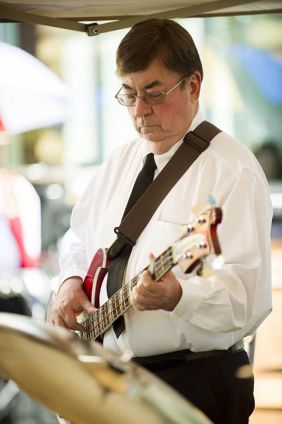 |
| Danelectro Bass Guitar |
Yesterday I watched the Tom Hanks film "
That Thing You Do," about a fictional rock band in Pittsburgh in 1964. This band calls themselves the "Oneders" (pronounced "wonders") but everyone thinks the name is pronounced "the Oh-Needers." Cute.
The drummer, Guy Patterson, is the chief protagonist. He is asked to sit in for the Oh-Needers regular drummer (who has broken an arm) at a talent competition. The band plays their own composition, "That Thing You Do." It's supposed to be a ballad but drummer Guy speeds up the beat considerably, making it an up-tempo tune, over the objections of the band leader Jimmy. The song is an instant hit and the band wins the talent contest.
After playing in a local pizza parlor and making an amateurish record of "That Thing You Do," the band is discovered by a talent scout and are on their way to fame and glory. They trade in their cheap Silvertone guitars and Danelectro bass guitar for better instruments. I liked the portrayal of the instruments, and found them to be historically accurate for the time period. Lead guitar player Lenny upgrades to a Fender Jazzmaster guitar, and the bass player trades his Danelectro for a Fender Jazz Bass, which was identical to my first bass, a 1960 Fender Jazz Bass in three color sunburst, complete with chrome tailpiece and string cover.
The only sour note in this accurate depiction was Jimmy's 12-string, '63 Rickenbacker guitar, identical to that played by George Harrison of the Beatles. There is no 12 string sound in any of the songs, and the instrument seems out of place in what is essentially a bubblegum band -- toothless music targeted for pubescent schoolgirls. (When I think of Rickenbacker, I think of the earthy blues of Creedence Clearwater or the British Rock of the Beatles, or the psychedelic rock of the Jefferson Airplane.)
Other things about the movie bugged me.
 |
| Fender Jazz Bass, 1960 |
Young people are shown with small portable radios with white earphones, similar to those used today for iPhones. Portable radios and even earphones were in use back then, but were rarely (if ever) seen on the street. No one in the band has long hair, though by 1964 every male teenager in the country was busily growing it out to emulate the Beatles.
Jimmy, the guitar player, comes closest to an authentic 60's hairstyle. He resembles Dave Clark of the Dave Clark Five, also popular around that time period. Indeed, in one shot of the band, they are wearing white turtlenecks under black suits, making them look very much like the
Dave Clark Five.
Blacks depicted in the film were politically correct to an absurd level, portraying them as beings of light rather than real human beings with faults and frailties. They include Lamarr, the head bellhop of the Los Angeles hotel where the band stays. Lamarr is Mr. Effervescence, nicer than pie, positive-thinking-on-steroids, and matchmaker to Guy and Faye (the band's only groupie). He is too nice to be real.
Likewise for Del Paxton, the piano player of a jazz band and musical hero to Guy, who finally meets his hero in an L.A. club called "the Blue Spot." Del is also super positive, upbeat and offers sagacious advice to Guy, some of which is memorable, like never depending on a band, because "bands come and go," and you have to keep playing with whomever you can. I like the Del character, but again, he is almost too nice to be real. Now if he smoked cigars, had a few tattoos, maybe an earring, knocked back a few more whiskeys and swore a little, I could believe he's real. The characterization was too saccharine for me.
Other blacks included a female singing group reminiscent of the Supremes, highly coiffed, dressed in pastel colors and looking pretty, but singing tunes even too cheesy for the early 1960's. In one scene they are singing "When you're holding my hand, you're holding my heart," followed by hand claps. I had a brief mental image of a doctor holding a beating heart during surgery as I suppressed a brief wave of nausea. C'mon! The Sixties were never that corny.
In the end, of course, the band is dissolved by the same forces that destroy many popular bands: egos, the desire to play some other genre of music other than the one that made them famous, differing goals and visions, personal jealousies and annoyances.
Del Paxton had that right: you can't depend on a band, so play when you can, with whom you can. If you're good enough, you'll always have opportunities to play and perform.






















